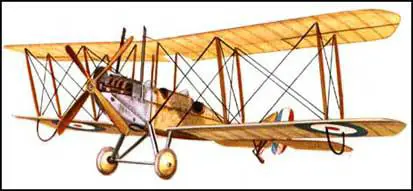BE-2
The BE-2 biplane was first developed by Geoffrey De Havilland in 1912 and by August 1914 was the standard military aircraft employed by the Royal Flying Corps (RFC). Although slow, it was stable and therefore played an important reconnaissance role in the early part of the First World War. The design of the plane was constantly being revised and during the war there were five different versions.
The BE-2, with improved tail and wing design; was used by RFC for reconnaissance and light bombing on the Western Front during 1914. The BE-2b had better cockpit protection and more refined controls. By autumn 1915 the BE-2b had been withdrawn and replaced by the BE-2c. With its modified engine for extra stability and the addition of an observer's machine-gun, the BE-2c was Britain's attempt to cope with the superior German Fokker D-VII. The BE-2d could travel longer distances and the BE-2e (introduced in 1916) was faster than previous models. The BE-2e remained in use on the Western Front until the middle of 1917.
In 1918 the BE-2 was mainly used as a defence against Zeppelin raids or on anti-submarine duties for the Royal Navy. It was also widely used to train pilots and a total of more than 3,000 had been manufactured by the end of the War.

Performance Data of the B.E.2c | |
|---|---|
Type | reconnaissance/light bomber |
Engine | 70 hp Renault |
Wing Span | 35 ft (10.68 m) |
Length | 29 ft 6 in (9 m) |
Height | 10 ft 2 in (3.1 m) |
Maximum Speed | 70 mph (112 kph) |
Maximum Height | 10,000 ft (3,048 m) |
Endurance | 3 hours |
Armament | 100 lbs (45.35kg) bombs |
Primary Sources
(1) The BE-2c was considered to be a good aircraft to use against German bombing missions at night. On 16th November 1915 the War Office sent out information on what aircraft should be used against the German bombers.
It is realised that there are considerable risks attendant on flying at night, but these risks are minimised when pilots practice over their own aerodromes. At the same time, the officers selected for this duty should be very carefully chosen. Only stable machines, such as the BE-2c, are to be used for this purpose.
(2) On 13th July 1916, Squadron Commander John Babington was asked by the Royal Flying Corps to write a report on night flying.
Essential requirements for night-flying aircraft include: inherent stability, durability, engine reliability, good vision for the crew, slow landing speed, fast rate of climb, silence, and a rugged undercarriage. Of existing aircraft I favour the BE-2c.
(3) In 1916 the BE-12 were brought in to replace the BE-2c. At first the BE-12 were not popular with the pilots. Claude Ridley and Douglas Cooke were two of the pilots who complained about the BE-12.
Claude Ridley: The BE-12 climbs so very poorly and is so very slow at a height in comparison with a good machine. It takes a long time to reach 14,000 ft and at this height there is no reserve of power, which seems absolutely useless when it comes to attacking first-class German machines.
Douglas Cooke: The BE12 will not climb above 14,000 ft and at that height it is impossible to do a sharp turn without losing about 500 ft, owing to the fact that the machine has no power reserve, and it is only just able to keep that height.
